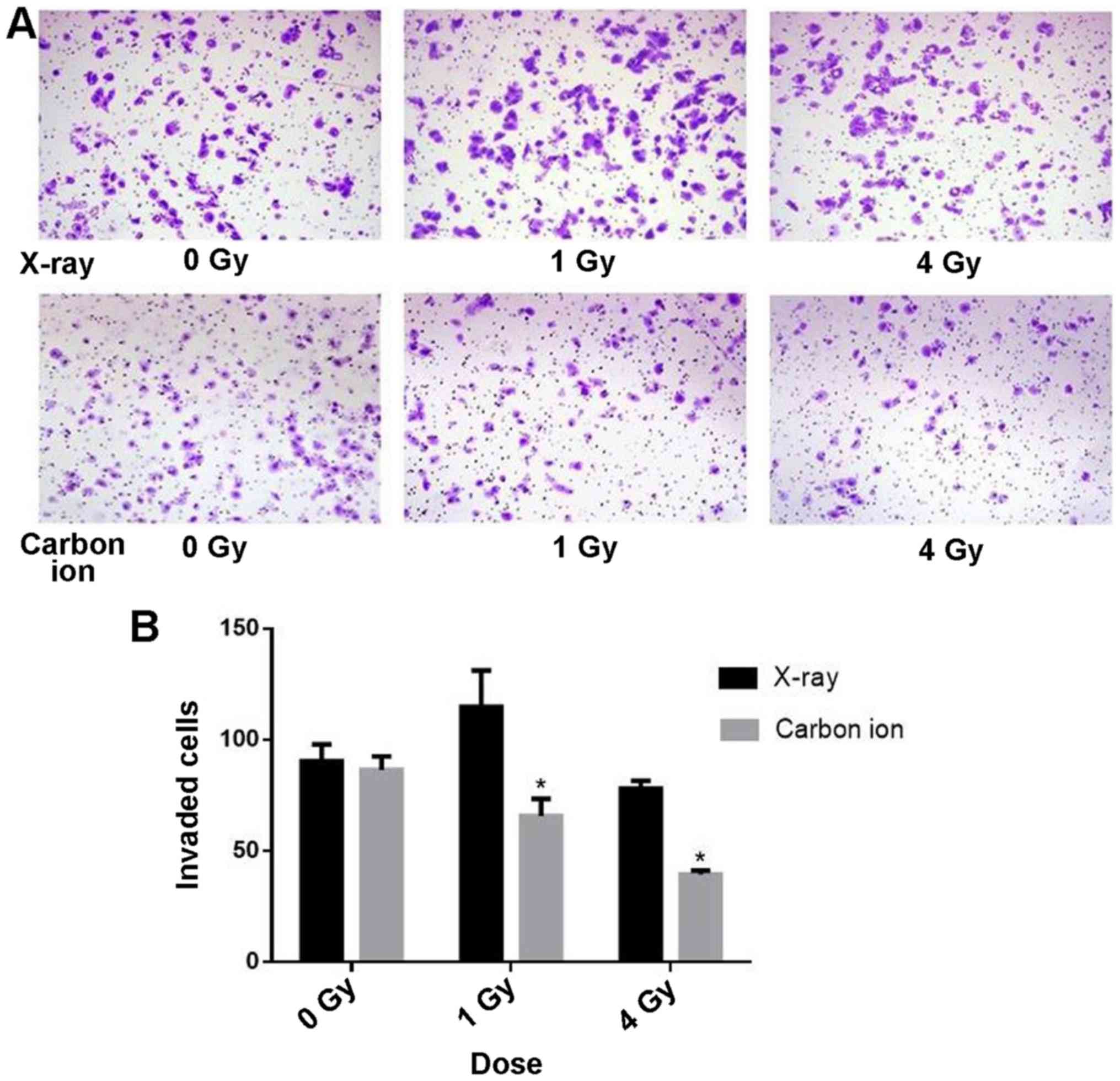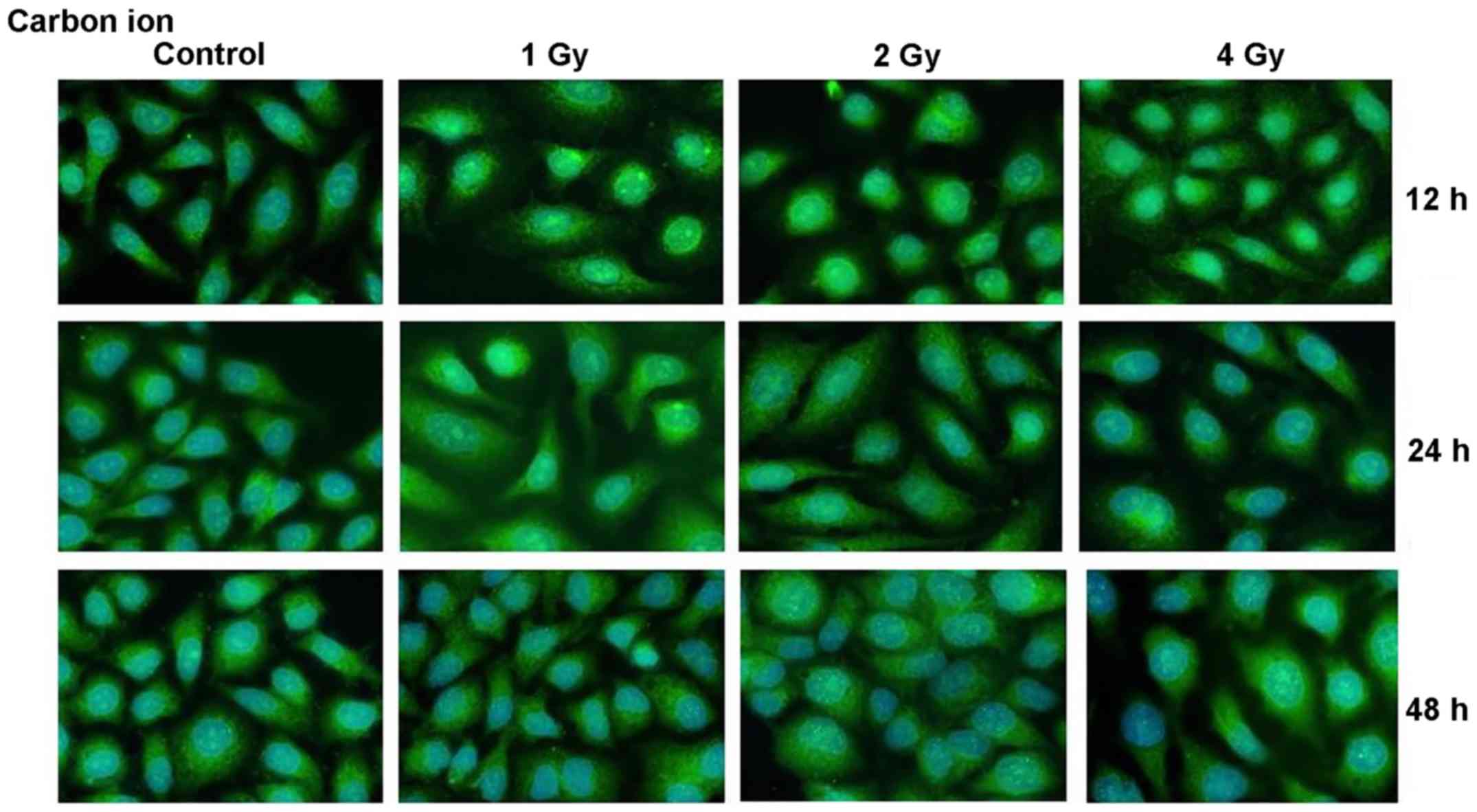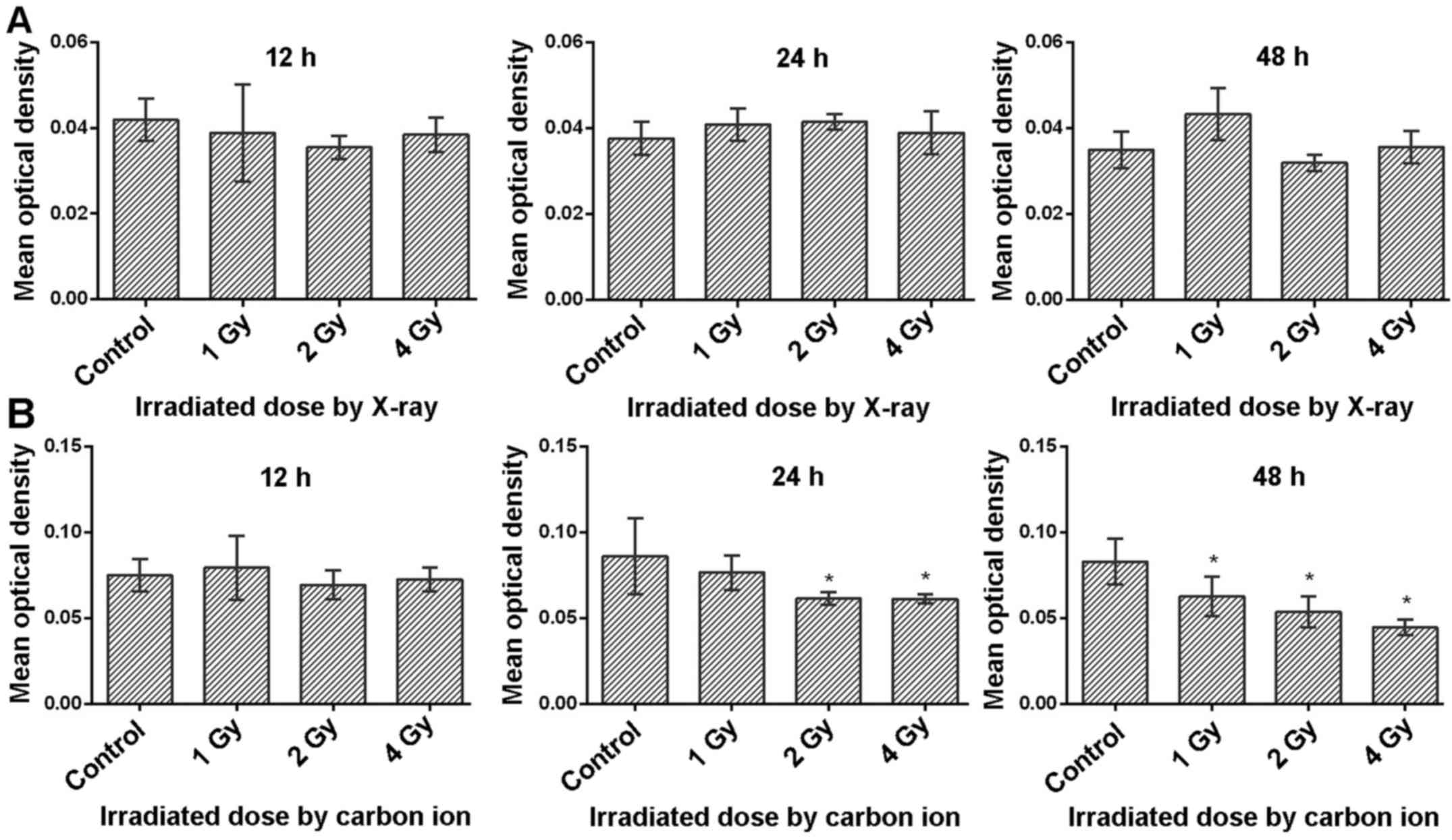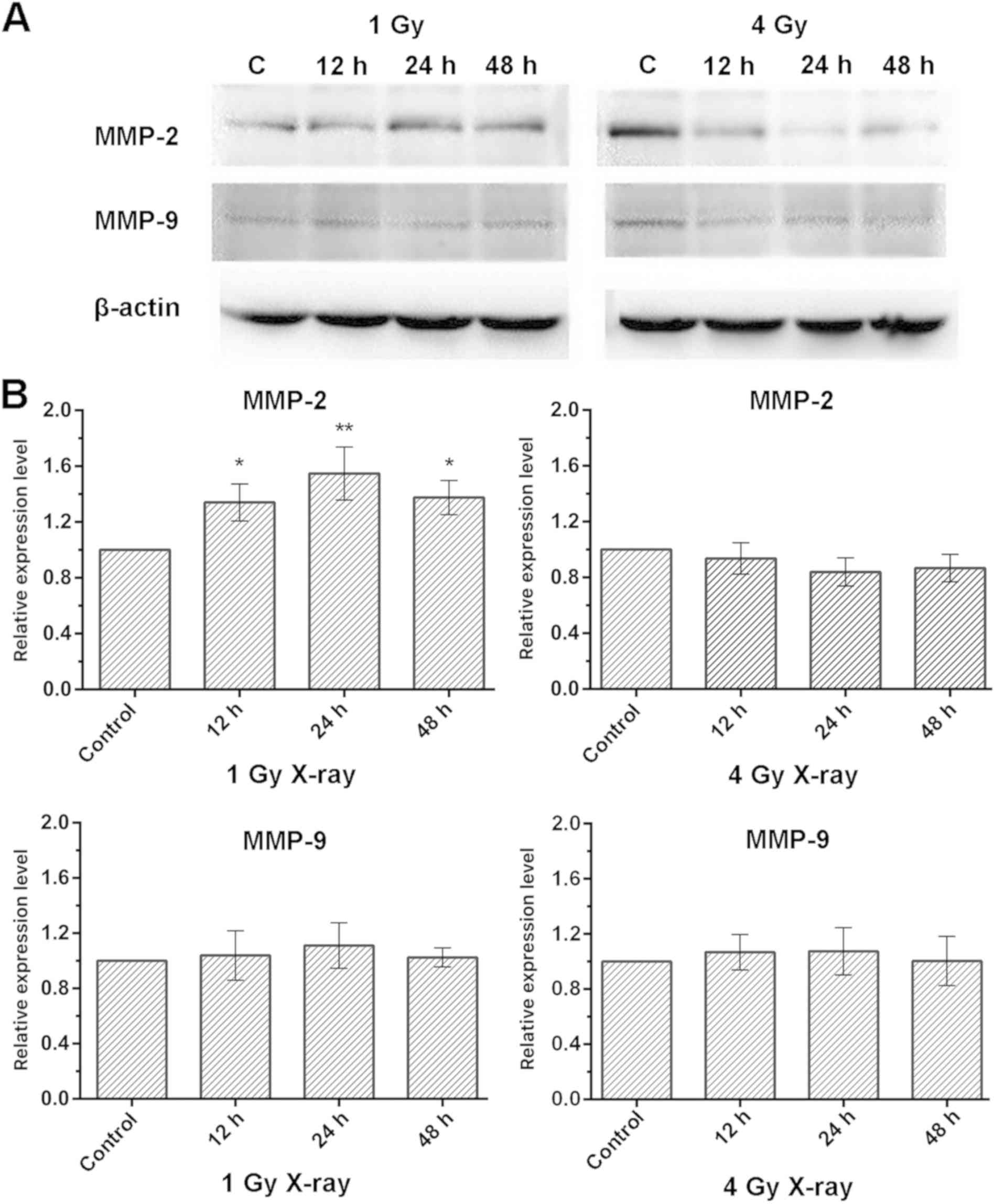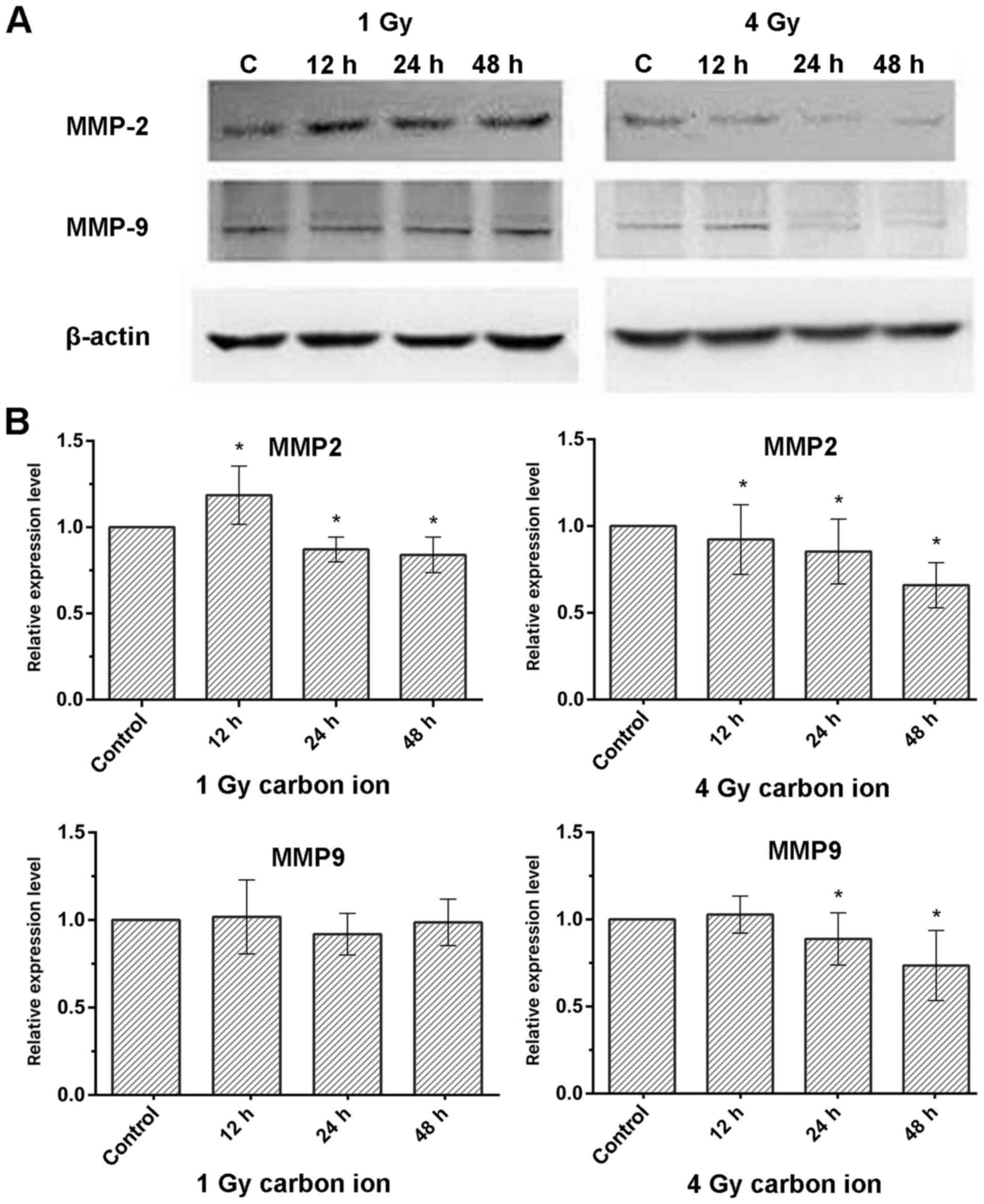Heavy‑ion beam irradiation inhibits invasion of tongue squamous cell carcinoma Tca8113 cells
- Authors:
- Published online on: August 16, 2019 https://doi.org/10.3892/ol.2019.10761
- Pages: 4092-4099
-
Copyright: © Feng et al. This is an open access article distributed under the terms of Creative Commons Attribution License.
Abstract
Introduction
Tongue squamous cell carcinoma (TSCC) is the most common type of oral squamous cell carcinoma and exhibits aggressive biological characteristics (1–3). Despite advances in therapeutic techniques and management, TSCC has a poor prognosis due to the frequent incidence of invasion and metastasis in the early stages (4). Radiotherapy, as an important adjuvant treatment modality, reduces relapse rates and increases survival rates in patients with TSCC; however, severe complications, including mucositis, hyposalivation, taste loss, osteoradionecrosis, dysphagia and swallowing deterioration, limit the success of clinical application (5–7). Therefore, it is important to understand the mechanisms underlying the growth, invasion and metastasis of these tumors in order to develop novel therapeutic strategies against TSCC.
High linear energy transfer (LET) heavy ion irradiation, including carbon ions, has several advantages over conventional low-LET X-rays, as it delivers a high dose to the tumor, while minimizing the dose delivered to surrounding healthy tissues (8). Therefore, heavy ion radiotherapy is increasingly being regarded as an effective therapeutic strategy for suppressing the invasive and metastatic radiation-resistant malignant tumors (9,10). Clinical data have demonstrated that numerous types of tumor of various pathological types, including squamous cell carcinoma, lung cancer and non-squamous cell types, such as adenocarcinoma, adenoid cystic carcinoma, bone and soft-tissue tumors, can be treated with carbon ions (10). Carbon ion radiation suppresses the angiogenesis potential of human endothelial ECV304 cells via inhibiting matrix metalloproteinase (MMP)-2 activity, and additionally suppresses the migration and invasion of human lung adenocarcinoma A549 cells by downregulating expression of the anillin gene (11,12). However, heavy ion radiation has not received much attention in oral squamous cell carcinoma, which is well known for its invasive and metastatic characteristic (3,4). Angiogenesis and degradation of the extracellular matrix (ECM) serve an important role in tumor growth, invasion and metastasis of TSCC (13). Vascular endothelial growth factor (VEGF), epidermal growth factor and certain enzymes secreted by tumor cells, including MMPs, promote migration and metastasis (13). Substantial evidence has demonstrated that the overexpression of VEGF, MMP-2 and MMP-9 is associated with infiltration and metastasis of TSCC (14,15); therefore, it is conceivable that their downregulation may inhibit invasion and metastasis in TSCC.
The aim of the present study was to investigate the expression of VEGF, MMP-2 and MMP-9 in TSCC Tca8113 cells following exposure to high-LET carbon ions and low-LET X-rays, and to provide some basic data for the efficacy of heavy ion radiation therapy against TSCC.
Materials and methods
Cell culture
The human TSCC cell line Tca8113 was obtained from the China Center for Type Culture Collection (Wuhan, China). Cells were cultured in RPMI-1640 medium (Thermo Fisher Scientific, Inc., Waltham, MA, USA) supplemented with 10% heat-inactivated fetal bovine serum (FBS; Minghai Biochem, Lanzhou, China), 100 U/ml penicillin and 100 µg/ml streptomycin, 1% sodium pyruvate and 2 mM glutamine (all obtained from Thermo Fisher Scientific, Inc.) at 37°C with 5% CO2 and 95% humidity. Cells were seeded in 35 mm glass Petri dishes (Nunc GmbH, Wiesbaden, Germany), and cell density was adjusted to 5×105 cells/ml at 24 h prior to irradiation. The cultured cells were divided into two groups; one group of cells were treated by X-ray, while the other were treated by heavy ion beam.
Irradiation procedure
The two groups of Tca8113 cells were irradiated at room temperature with carbon ions or X-rays. The irradiation with carbon ions was conducted in the Heavy Ion Research Facility in Lanzhou (HIRFL) at the Institute of Modern Physics, Chinese Academy of Sciences (Lanzhou, China). Tca8113 cells were exposed to a carbon ion beam with energy of 250 MeV/u supplied by HIRFL. The LET value of the beam was adjusted to 75 keV/µm and the dose rate was ~1 Gy/min. For X-ray irradiation, cell samples were treated at room temperature with an X-ray irradiation system (Faxitron RX-650; Faxitron Bioptics LLC, Tuscon, AZ, USA) at 50 kVp with a dose rate of 0.5 Gy/min. The doses applied in this experiment were 0, 1, 2 and 4 Gy for both irradiations. Following irradiation, the cells were incubated under normal culture conditions for 12, 24 and 48 h. The control cells were sham-irradiated.
Cell invasion assay
Cell invasion assay was performed using Transwell inserts with 8-µm pores and coated with Matrigel (BD Biosciences, Franklin Lakes, NJ, USA), which was used as a basement membrane equivalent, and is composed of extracellular matrix designed to mimic the typical matrices that tumor cells encounter during the invasion process in vivo. Cells irradiated with carbon ions or X-rays at doses of 0, 1 and 4 Gy were treated with trypsinase and resuspended in serum-free RPMI-1640, after which 200 µl (2×105 cells/ml) cell suspension was added to the upper chambers. The lower chambers were filled with 600 µl RPMI-1640 supplemented with 10% FBS as a chemo-attractant. Following incubation under normal culture conditions for 24 h, the non-invading cells on the upper surface of the filters were scraped away using a cotton swab. The cells that had invaded to the lower surface of the filters were fixed in ethanol and stained with Giemsa at room temperature for 20 min. Subsequently, the cells were counted in five random fields under a light microscope (Olympus, Tokyo, Japan) at ×100 magnification.
Western blotting
Cells irradiated with carbon ions or X-rays at doses of 0, 1 and 4 Gy were collected at 12, 24 and 48 h post-irradiation. The cells were rinsed twice with ice-cold PBS prior to being lysed in lysis buffer (Wuhan Boster Biological Technology, Ltd., Wuhan, China). Subsequently, the cell lysates were centrifuged at 16,100 × g for 10 min at 4°C. The supernatant was collected, and the amount of protein was estimated using a bicinchoninic acid protein assay kit (Bioworld Technology, Inc., St. Louis Park, MN, USA). Equal quantities of protein (30 µg) were loaded onto an 8% SDS-PAGE gel and the separated proteins were transferred onto polyvinylidene difluoride membranes (Roche Diagnostics, Basel, Switzerland) for 1 h at 100 V. After transfer, the membranes were blocked in 5% bovine serum albumin (BSA; Lanzhou Minhai Bioengineering Co., Ltd.) at room temperature for 2 h and subsequently incubated overnight at 4°C with anti-MMP-2 (cat. no. 4022), anti-MMP-9 (cat. no. 3852; Cell Signaling Technology, Inc., Danvers, MA, USA) or anti-β-actin (cat. no. TA-09; all used at 1:1,000; Beijing Zhongshan Golden Bridge Biotech Co., Ltd., Beijing, China). Blots were rinsed with TBS (pH 7.4) and 0.05% Tween-20, and incubated with horseradish peroxidase-conjugated anti-mouse monoclonal antibody (cat. no. ZB-2305) or anti-rabbit polyclonal antibody (cat. no. ZB-2301; both 1:2,000; Beijing Zhongshan Golden Bridge Biotech Co., Ltd.) for 2 h at 37°C. Immunoreactive proteins were detected using the ECL western blotting kit (Bioworld Technology, Inc.). Bands were scanned and detected using a chemiluminescent imaging system (Tanon 4200 SF; Tanon Science and Technology Co., Ltd., Shanghai, China) and the density of bands were quantified using the Quantity One software (v4.4, Bio-Rad Laboratories, Inc., Hercules, CA, USA).
Indirect immunofluorescence assay
For indirect immunofluorescence, Tca8113 cells (1×105 cells/ml) were grown on glass coverslips and cultured at 37°C at 5% CO2 for 24 h until the cells were fully attached to the glass coverslips prior to irradiation. In order to confirm whether the effect of irradiation was dose-dependent, cells were irradiated with carbon ions or X-rays at doses of 0, 1, 2 and 4 Gy and collected at 12, 24 and 48 h post-irradiation. Cells were fixed in 4% paraformaldehyde for 15 min at room temperature, then permeabilized with 0.1% Triton X-100 for 2 min, washed in PBS, and blocked in 5% BSA (Lanzhou Minhai Bioengineering Co., Ltd.) at room temperature for 30 min. Subsequently, the coverslips were washed and incubated with mouse anti-human monoclonal antibody VEGF (cat. no. ab1316; 1:200; Abcam, Cambridge, MA, USA) at 37°C for 2 h, washed three times in PBS, and incubated with fluorescein-isothiocyanate-labeled donkey anti-mouse antibody IgG (cat. no. ab7057; 1:800; Abcam, Cambridge, MA, USA), at 37°C for 1 h. Nuclear DNA was stained with DAPI (Sangon Biotech Co., Ltd., Shanghai, China) at room temperature for 10 min. The coverslips were evaluated and images were captured using a fluorescence microscope (Olympus) at ×1,000 magnification.
Statistical analysis
All experiments were repeated at least three times. Data are presented as the mean ± standard deviation and analyzed using SPSS version 13.0 (SPSS, Inc., Chicago, IL, USA). Groups were compared using ANOVA with Bonferroni's post-hoc test. P<0.05 was considered to indicate a statistically significant difference.
Results
Effects of irradiation on cell invasion
The cell invasion assay was used to investigate the effects of irradiation with carbon ions and X-rays on the invasion of Tca8113 cells. The rate of invasion in cells irradiated with carbon ions was decreased with increasing doses of radiation, and was significantly decreased compared with cells exposed to X-ray irradiation at the same dose (P<0.05; Fig. 1).
Effects of irradiation on VEGF expression
The expression of VEGF in Tca8113 cells irradiated with carbon ions and X-rays was evaluated by immunofluorescence (Figs. 2 and 3). Compared with the control cells (sham-irradiated), there was no significant change in VEGF expression at 12, 24 or 48 h after X-ray irradiation with different doses. However, VEGF was significantly downregulated at 24 h after carbon ion irradiation at a dose of 2 Gy, and significantly decreased in a dose-dependent manner at 48 h, as indicated in Fig. 4 (P<0.05).
Effects of irradiation on MMP-2 and MMP-9 protein expression
MMP-2 and MMP-9 expression were detected by western blot. Compared with the control cells (sham-irradiated), there was a significant increase in MMP-2 expression in Tca8113 cells treated with X-rays at a low dose (1 Gy; P<0.05; Fig. 5A and B). However, there was no significant difference in MMP-9 expression among cells irradiated with the same dose of X-ray irradiation. In Tca8113 cells irradiated with carbon ions, MMP-2 expression was downregulated at the low dose (1 Gy) except 12 h post-irradiation and also decreased at the high dose (4 Gy) over time post-irradiation. Similar to MMP-2 expression, the level of MMP-9 expression also decreased in Tca8113 cells irradiated at the high dose (4 Gy), although no significant change was observed at the low dose (1 Gy; P>0.05; Fig. 6A and B).
Discussion
Successful treatment of TSCC is frequently complicated by invasion and metastasis, which may severely impact survival and quality of life in patients (1,16–18). Radiotherapy provides an auxiliary treatment strategy for this disease. Although it is an effective strategy for local control of the primary tumor, recurrence and metastasis are frequently observed in patients with TSCC (19). Therefore, the suppression of invasion and metastasis are considered to be critical therapeutic targets for TSCC (20–22). Previous studies have demonstrated that high-LET particles, including carbon ions, are more effective compared with low-LET radiation, including X-rays, in suppressing tumor cell invasion (12,23). However, the responses of tumor cells to radiation are different and complex (24,25). The invasion of a malignant tumor is a complicated phenomenon involving angiogenesis, adhesion of the cell to the ECM, degradation of the ECM and invasion of the cell into the surrounding tissues (26,27). The metastatic potential of the non-small cell lung cancer A549 cell line and the lung squamous cell carcinoma EBC-1 cell line has been reported to be inhibited by heavy ions (12), therefore we hypothesized that high-LET heavy ions may inhibit the metastatic potential of Tca8113 cells. Therefore, in the present study, the biological effects of heavy ion irradiation on cells were investigated, including invasion and the expression levels of molecules associated with metastasis, including MMP-2, MMP-9 and VEGF.
There are numerous factors associated with metastatic potential. During the process of tumor invasion and metastasis, the basement membrane, which mainly consists of type IV collagen, is degraded by numerous types of enzyme, including serine proteinases, cysteine proteinases and MMPs (13). Among the secreted MMPs, MMP-2 and MMP-9 serve important roles in tumor invasion and metastasis (28,29). Therefore, the aim of the present study was to determine whether MMP-2 or MMP-9 expression was altered in response to irradiation in malignant tumor cells. Wild-Bode et al (30) demonstrated that irradiating glioma cells with sub-lethal X-ray doses resulted in an increase in MMP-2 activity and promoted invasiveness of the cells. Similar findings have been reported for other cancer cell types, including those of the liver, lung and pancreas (31–33). The results of the present study additionally demonstrated that the expression level of MMP-2 increased following X-ray irradiation of 1 Gy in Tca8113 cells. Notably, for Tca8113 cells irradiated with heavy ions, the invasive ability significantly decreased in a dose-dependent manner, and the expression of MMP-2 protein was downregulated at both low dose (1 Gy) and a high doses (4 Gy) over time, in accordance with the findings by Ogata et al (23). There was no significant difference in MMP-9 expression in Tca8113 cells irradiated with different doses of X-rays (1, 2 and 4 Gy) and a low dose of carbon ions (1 Gy) at the same time points, but the expression of MMP-9 was decreased in Tca8113 cells exposed to a high dose of carbon ions (4 Gy). These results are consistent with a previous study (11), suggesting that high-LET heavy ions may suppress the invasiveness of Tca8113 cells via downregulating MMP-2 and MMP-9 expression.
VEGF, a heparin-binding glycoprotein, has five known isoforms, and is an important growth factor in the progression and angiogenesis of malignant tumors (34). It was demonstrated that radiation induces VEGF expression in a range of tumor cell lines (35), and that certain tumor cells protect themselves against radiotherapy via the release of VEGF (36). In the present study, there was no notable difference in the expression of VEGF in Tca8113 cells irradiated with X-rays compared with non-irradiated cells. By contrast, VEGF levels significantly decreased in cells irradiated with carbon ions compared with non-irradiated cells supporting the results of a previous study by Liu et al (37), who reported that carbon ion radiation decreased VEGF secretion in lung adenocarcinoma A549 cells. As the immunofluorescence assay can only show the location of the target protein and cannot detect the molecular weight of the protein, the effect of irradiation on VEGF expression needs to be confirmed using western blot analysis in future experiments. One possible explanation for the carbon ion radiation mediated decrease may be that radiation with carbon ions may cause more complex and irreparable clustered DNA damage compared with X-rays. DNA repair is inefficient following high-LET particle irradiation, which may lead to chromosomal damage and eventually, cell death (38,39). Further studies are required in order to improve understanding of the mechanism of action of carbon ions on organisms.
In summary, the present study indicated that high-LET carbon ion radiation has the potential to decrease Tca8113 cell invasion in a dose-dependent manner and this effect may be via the inhibition of MMP-2, MMP-9 and VEGF. These findings provide evidence that heavy-ion radiation therapy may be superior to radiotherapy with conventional X-rays for the clinical management of TSCC.
Acknowledgements
The authors would like to thank Dr Xiaodong Jin (Institute of Modern Physics, Chinese Academy of Sciences) for his advice with regards to conducting this experiment.
Funding
This study was supported by the National Natural Science Foundation of China (grant no. 81260403) and the Gansu Provincial Youth Science and Technology Fund Project (grant no. 17JR5RA275).
Availability of data and materials
The datasets used and/or analyzed during the present study are available from the corresponding author on reasonable request.
Authors' contributions
ZF and CL designed the experiments and wrote the draft manuscript. QZ, WM, TL and LX participated in the experiments and analysis, and prepared the background research. QL designed the experiments and revised the final manuscript. All authors read and approved the final manuscript.
Ethics approval and consent to participate
Not applicable.
Patient consent for publication
Not applicable.
Competing interests
The authors declare that that they have no competing interests.
Glossary
Abbreviations
Abbreviations:
|
TSCC |
tongue squamous cell carcinoma |
|
VEGF |
vascular endothelial growth factor |
|
LET |
linear energy transfer |
|
MMP |
matrix metalloproteinase |
|
ECM |
extracellular matrix |
References
|
Jemal A, Bray F, Center MM, Ferlay J, Ward E and Forman D: Global cancer statistics. CA Cancer J Clin. 61:69–90. 2011. View Article : Google Scholar : PubMed/NCBI | |
|
Chandler K, Vance C, Budnick S and Muller S: Muscle invasion in oral tongue squamous cell carcinoma as a predictor of nodal status and local recurrence: Just as effective as depth of invasion? Head Neck Pathol. 5:359–363. 2011. View Article : Google Scholar : PubMed/NCBI | |
|
Mücke T, Mitchell DA, Wagenpfeil S, Ritschl LM, Wolff KD and Kanatas A: Incidence and outcome for patients with occult lymph node involvement in T1 and T2 oral squamous cell carcinoma: A prospective study. BMC Cancer. 14:3462014. View Article : Google Scholar : PubMed/NCBI | |
|
Ganly I, Patel S and Shah J: Early stage squamous cell cancer of the oral tongue-clinicopathologic features affecting outcome. Cancer. 118:101–111. 2012. View Article : Google Scholar : PubMed/NCBI | |
|
Vissink A, Jansma J, Spijkervet FK, Burlage FR and Coppes RP: Oral sequelae of head and neck radiotherapy. Crit Rev Oral Biol Med. 14:199–212. 2003. View Article : Google Scholar : PubMed/NCBI | |
|
Wong HM: Oral complications and management strategies for patients undergoing cancer therapy. ScientificWorldJournal. 2014:5817952014. View Article : Google Scholar : PubMed/NCBI | |
|
Silveira MH, Dedivitis RA, Queija DS and Nascimento PC: Quality of life in swallowing disorders after nonsurgical treatment for head and neck cancer. Int Arch Otorhinolaryngol. 19:46–54. 2015. View Article : Google Scholar : PubMed/NCBI | |
|
Kraft G: The radiobiological and physical basis for radiotherapy with protons and heavier ions. Strahlenther Onkol. 166:10–13. 1990.PubMed/NCBI | |
|
Halperin EC: Particle therapy and treatment of cancer. Lancet Oncol. 7:676–685. 2006. View Article : Google Scholar : PubMed/NCBI | |
|
Kamada T, Tsujii H, Blakely EA, Debus J, De Neve W, Durante M, Jäkel O, Mayer R, Orecchia R, Pötter R, et al: Carbon ion radiotherapy in Japan: An assessment of 20 years of clinical experience. Lancet Oncol. 16:e93–e100. 2015. View Article : Google Scholar : PubMed/NCBI | |
|
Takahashi Y, Teshima T, Kawaguchi N, Hamada Y, Mori S, Madachi A, Ikeda S, Mizuno H, Ogata T, Nojima K, et al: Heavy ion irradiation inhibits in vitro angiogenesis even at sublethal dose. Cancer Res. 63:4253–4257. 2003.PubMed/NCBI | |
|
Akino Y, Teshima T, Kihara A, Kodera-Suzumoto Y, Inaoka M, Higashiyama S, Furusawa Y and Matsuura N: Carbon-ion beam irradiation effectively suppresses migration and invasion of human non-small-cell lung cancer cells. Int J Radiat Oncol Biol Phys. 75:475–481. 2009. View Article : Google Scholar : PubMed/NCBI | |
|
Koontongkaew S: The tumor microenvironment contribution to development, growth, invasion and metastasis of head and neck squamous cell carcinomas. J Cancer. 4:66–83. 2013. View Article : Google Scholar : PubMed/NCBI | |
|
Kim SH, Cho NH, Kim K, Lee JS, Koo BS, Kim JH, Chang JH and Choi EC: Correlations of oral tongue cancer invasion with matrix metalloproteinases (MMPs) and vascular endothelial growth factor (VEGF) expression. J Surg Oncol. 93:330–337. 2006. View Article : Google Scholar : PubMed/NCBI | |
|
Matsui T, Shigeta T, Umeda M and Komori T: Vascular endothelial growth factor C (VEGF-C) expression predicts metastasis in tongue cancer. Oral Surg Oral Med Oral Pathol Oral Radiol. 120:436–442. 2015. View Article : Google Scholar : PubMed/NCBI | |
|
Liu WH, Li X, Zhu XL, Hou ML and Zhao W: CD63 inhibits the cell migration and invasion ability of tongue squamous cell carcinoma. Oncol Lett. 15:9033–9042. 2018.PubMed/NCBI | |
|
Sano D and Myers JN: Metastasis of squamous cell carcinoma of the oral tongue. Cancer Metastasis Rev. 26:645–662. 2007. View Article : Google Scholar : PubMed/NCBI | |
|
Olaleye O, Ekrikpo U, Lyne O and Wiseberg J: Incidence and survival trends of lip, intra-oral cavity and tongue base cancers in south-east England. Ann R Coll Surg Engl. 97:229–234. 2015. View Article : Google Scholar : PubMed/NCBI | |
|
Sun C, Wang X, Zhong Z, Wang W, Luo J, Chen X, Chu H, Tao X and Yang A: Differences in clinicopathological characteristics and prognosis between primary and postirradiation tongue squamous cell carcinoma. J Oral Maxillofac Surg. 75:2235–2241. 2017. View Article : Google Scholar : PubMed/NCBI | |
|
Roy R, Yang J and Moses MA: Matrix metalloproteinases as novel biomarkers and potential therapeutic targets in human cancer. J Clin Oncol. 27:5287–5297. 2009. View Article : Google Scholar : PubMed/NCBI | |
|
Jiang L, Liu X, Kolokythas A, Yu J, Wang A, Heidbreder CE, Shi F and Zhou X: Downregulation of the Rho GTPase signaling pathway is involved in the microRNA-138-mediated inhibition of cell migration and invasion in tongue squamous cell carcinoma. Int J Cancer. 127:505–512. 2010. View Article : Google Scholar : PubMed/NCBI | |
|
Shang B, Cao Z and Zhou Q: Progress in tumor vascular normalization for anticancer therapy: Challenges and perspectives. Front Med. 6:67–78. 2012. View Article : Google Scholar : PubMed/NCBI | |
|
Ogata T, Teshima T, Kagawa K, Hishikawa Y, Takahashi Y, Kawaguchi A, Suzumoto Y, Nojima K, Furusawa Y and Matsuura N: Particle irradiation suppresses metastatic potential of cancer cells. Cancer Res. 65:113–120. 2005.PubMed/NCBI | |
|
Hill RP: The changing paradigm of tumour response to irradiation. Br J Radiol. 90:201604742017. View Article : Google Scholar : PubMed/NCBI | |
|
Matsuda S, Furuya K, Ikura M, Matsuda T and Ikura T: Absolute quantification of acetylation and phosphorylation of the histone variant H2AX upon ionizing radiation reveals distint cellular responses in two cancer cell lines. Radiat Environ Biophys. 54:403–411. 2015. View Article : Google Scholar : PubMed/NCBI | |
|
Chambers AF, Groom AC and MacDonald IC: Dissemination and growth of cancer cells in metastatic sites. Nat Rev Cancer. 2:563–572. 2002. View Article : Google Scholar : PubMed/NCBI | |
|
Joyce JA and Pollard JW: Microenvironmental regulation of metastasis. Nat Rev Cancer. 9:239–252. 2009. View Article : Google Scholar : PubMed/NCBI | |
|
Xue Q, Cao L, Chen XY, Zhao J, Gao L, Li SZ and Fei Z: High expression of MMP9 in glioma affects cell proliferation and is associated with patient survival rates. Oncol Lett. 13:1325–1330. 2017. View Article : Google Scholar : PubMed/NCBI | |
|
Fan HX, Li HX, Chen D, Gao ZX and Zheng JH: Changes in the expression of MMP2, MMP9, and ColIV in stromal cells in oral squamous tongue cell carcinoma: Relationships and prognostic implications. J Exp Clin Cancer Res. 31:902012. View Article : Google Scholar : PubMed/NCBI | |
|
Wild-Bode C, Weller M, Rimner A, Dichgans J and Wick W: Sublethal irradiation promotes migration and invasiveness of glioma cells: Implications for radiotherapy of human glioblastoma. Cancer Res. 61:2744–2750. 2001.PubMed/NCBI | |
|
Araya J, Maruyama M, Sassa K, Fujita T, Hayashi R, Matsui S, Kashii T, Yamashita N, Sugiyama E and Kobayashi M: Ionizing radiation enhances matrix metalloproteinase-2 production in human lung epithelial cells. Am J Physiol Lung Cell Mol Physiol. 280:L30–L38. 2001. View Article : Google Scholar : PubMed/NCBI | |
|
Qian LW, Mizumoto K, Urashima T, Nagai E, Maehara N, Sato N, Nakajima M and Tanaka M: Radiation-induced increase in invasive potential of human pancreatic cancer cells and its blockade by a matrix metalloproteinase inhibitor, CGS27023. Clin Cancer Res. 8:1223–1227. 2002.PubMed/NCBI | |
|
Cheng JC, Chou CH, Kuo ML and Hsieh CY: Radiation-enhanced hepatocellular carcinoma cell invasion with MMP-9 expression through PI3K/Akt/NF-kappaB signal transduction pathway. Oncogene. 25:7009–7018. 2006. View Article : Google Scholar : PubMed/NCBI | |
|
Flickinger I, Rütgen BC, Gerner W, Calice I, Tichy A, Saalmüller A and Kleiter M: Radiation up-regulates the expression of VEGF in a canine oral melanoma cell line. J Vet Sci. 14:207–214. 2013. View Article : Google Scholar : PubMed/NCBI | |
|
Gorski DH, Beckett MA, Jaskowiak NT, Calvin DP, Mauceri HJ, Salloum RM, Seetharam S, Koons A, Hari DM, Kufe DW and Weichselbaum RR: Blockage of the vascular endothelial growth factor stress response increases the antitumor effects of ionizing radiation. Cancer Res. 59:3374–3378. 1999.PubMed/NCBI | |
|
Park JS, Qiao L, Su ZZ, Hinman D, Willoughby K, McKinstry R, Yacoub A, Duigou GJ, Young CS, Grant S, et al: Ionizing radiation modulates vascular endothelial growth factor (VEGF) expression through multiple mitogen activated protein kinase dependent pathways. Oncogene. 20:3266–3280. 2001. View Article : Google Scholar : PubMed/NCBI | |
|
Liu Y, Liu Y, Zhang H, Sun C, Zhao Q, Di C, Li H, Gan L and Wang Y: Effects of carbon-ion beam irradiation on the angiogenic response in lung adenocarcinoma A549 cells. Cell Biol Int. 38:1304–1310. 2014. View Article : Google Scholar : PubMed/NCBI | |
|
Mohamad O, Sishc BJ, Saha J, Pompos A, Rahimi A, Story MD, Davis AJ and Kim DWN: Carbon ion radiotherapy: A review of clinical experiences and preclinical research, with an emphasis on DNA damage/repair. Cancers (Basel). 9(pii): E662017. View Article : Google Scholar : PubMed/NCBI | |
|
Hagiwara Y, Niimi A, Isono M, Yamauchi M, Yasuhara T, Limsirichaikul S, Oike T, Sato H, Held KD, Nakano T and Shibata A: 3D-structured illumination microscopy reveals clustered DNA double-strand break formation in widespread γH2AX foci after high LET heavy-ion particle radiation. Oncotarget. 8:109370–109381. 2017. View Article : Google Scholar : PubMed/NCBI |



